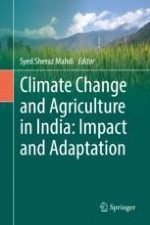Abstract
Indian Summer Monsoon (IMS) prevails during June–July-August-September (JJAS) and 80% of the annual precipitation is received during JJAS. The spatial and temporal variability of ISMR and surface temperature has been influencing agriculture and water resources. The changes in earth’s surface temperature is affecting the patterns of weather and climate and influencing the agriculture. The Coupled Model Inter comparison Project 5 (CMIP5) models output data is generally of higher resolution with different emission experiments and therefore rainfall and surface temperature over India is analyzed under CMIP5 which may be used for agricultural purposes.
The Indian Summer Monsoon Rainfall (ISMR) in simulation of BCC-CSM1.1(m), CCSM4, CESM1(BGC), CESM1(CAM5), CESM1(FASTCHEM), CESM1(WACCM), and MPI-ESM-MR for the period of 2006–2050 under RCPs 4.5 and 8.5 at 99% confidence shows possibility of excessrainfall over homogeneous monsoon regions of NWI, NEI, WCI and PI, while deficit rainfall over NWI, NEI, WCI, CNI and PI. At 99% and 95% confidence levels, deficit rainfall is found over CNI, NWI and PI. The CMIP5 model GISS-E2-H, BCC-CSM1.1 m and GISS-E2-H-CC for Tmax; GFDL-CM3, MRI-CGM3 and MRI-ESM1 for Tmin; and CESM1 (CAM5) for T under Representative Concentration Pathways (RCPs) 4.5 and 8.5 for the period of 2021–2055 shows possible significant warming of 0.5°C–0.7°C at 99% confidence level over homogeneous temperature regions of NC, NW, and WC. The warming of 0.2°C–0.5°C might be possible at other locations.
These future projections may be used in crop simulation models which may assist adaptation to climate change-through changes in farming practices, cropping patterns, and use of new technologies.
